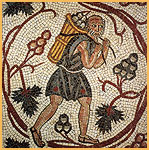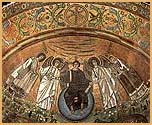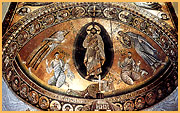|
The mosaic decoration
Mosaic, a medium in which small cubes of stone
or glass are set in a  mortar
bed, was a popular way of decorating interiors in Late Antiquity.
Floor mosaics in carpet' formations (a central panel surrounded
by a decorative border) were practically de rigueur during
this period. Floral and animalistic motifs, genre scenes,
architectural settings, and geometric compositions, were the
most common choices in mosaic iconography, both for domestic
and religious use. Specificaly Christian motifs and images
were relatively rare, but this natural world' imagery may
have been used at times with Christian significance to illustrate
the wonders of creation. Topographical mosaics were also popular:
the mosaic of the Yaqto Villa in Antioch (fifth century) shows
the bustling streets of this city and of suburban Daphne;
the sixth-century panel in the church of * in Madaba is a
map of Palestine. Pagan iconography adorns the houses of the
wealthy showing that the ruling classes were fond of antique
culture and perhaps favorable towards paganism, even at a
late date. Narrative scenes, such as Europe abducted by Zeus
or Dionysiac feasts, female allegorical busts, deities and
personnifications adorned reception rooms and sleeping quarters;
often, it is these panels that identify the function of a
particular room and the position of furniture. mortar
bed, was a popular way of decorating interiors in Late Antiquity.
Floor mosaics in carpet' formations (a central panel surrounded
by a decorative border) were practically de rigueur during
this period. Floral and animalistic motifs, genre scenes,
architectural settings, and geometric compositions, were the
most common choices in mosaic iconography, both for domestic
and religious use. Specificaly Christian motifs and images
were relatively rare, but this natural world' imagery may
have been used at times with Christian significance to illustrate
the wonders of creation. Topographical mosaics were also popular:
the mosaic of the Yaqto Villa in Antioch (fifth century) shows
the bustling streets of this city and of suburban Daphne;
the sixth-century panel in the church of * in Madaba is a
map of Palestine. Pagan iconography adorns the houses of the
wealthy showing that the ruling classes were fond of antique
culture and perhaps favorable towards paganism, even at a
late date. Narrative scenes, such as Europe abducted by Zeus
or Dionysiac feasts, female allegorical busts, deities and
personnifications adorned reception rooms and sleeping quarters;
often, it is these panels that identify the function of a
particular room and the position of furniture.
In large prestige buildings tessellated pavements gave
way to marble  slabs,
and monumental mosaics were used to adorn the walls and ceilings.
Religious iconography gained in complexity, with formal images
of holy personnae and extensive narrative cycles. The sanctuary
apse was the
focus for the Early Byzantine church. Early Byzantine apse
themes include divine epiphanies, namely the Ascension or
the Transfiguration, and formal portraits of holy personnae,
such as Christ in Majesty or the Virgin and Child. Apse compositions
also stress the role of the Virgin and patron saint as intercessors
for the salvation of mankind. slabs,
and monumental mosaics were used to adorn the walls and ceilings.
Religious iconography gained in complexity, with formal images
of holy personnae and extensive narrative cycles. The sanctuary
apse was the
focus for the Early Byzantine church. Early Byzantine apse
themes include divine epiphanies, namely the Ascension or
the Transfiguration, and formal portraits of holy personnae,
such as Christ in Majesty or the Virgin and Child. Apse compositions
also stress the role of the Virgin and patron saint as intercessors
for the salvation of mankind.
Often, there is reference to the site, dedication or
patronnage of the church. St Vitale in Ravenna (526-545) features
the Christ, enthroned on a globe and flanked by angels, St
Vitalis and Bishop Ecclesius, the latter carrying a model
of the church; on either side of the apse windows, Justinian,
Theodora and Bishop Maximianus bear gifts to the newly dedicated
church. The Transfiguration on the apse of St Catherine on
Mount Sinai (548-565) is combined with representations of
the local holy man Moses in the
chancel arch, while the face
of the donor Justinian may be recognized in a medallion of
David.
Stylistically, St Vitale and St Catherine illustrate
two different approaches  in
sixth-century mosaic art. In the former monument, solid, naturalistic
figures, set in a real' landscape, derive from classical
tradition. In comparison, the apse mosaic of the Transfiguration
on Mount Sinai, with its large angular figures suspended in
a solid gold background, is almost abstract. The modern approach
illustrated by the Transfiguration mosaic set the trend in
sixth-century Constantinople. The remains of St Sophia's gold
mosaic decoration are entirely non-figural and imitate the
effect of shimmering silks enlivened with geometric patterns.
Prokopios reports
that the church of St Sergius and Bacchus was adorned throughout
with gold, and
Anicia Julian
is said to have gilt the ceiling of St Polyeuktos in order
to prevent her wealth from falling into Justinian's hands,
after the emperor had requested a contribution to the imperial
treasury: both cases may refer to solid gold mosaic. in
sixth-century mosaic art. In the former monument, solid, naturalistic
figures, set in a real' landscape, derive from classical
tradition. In comparison, the apse mosaic of the Transfiguration
on Mount Sinai, with its large angular figures suspended in
a solid gold background, is almost abstract. The modern approach
illustrated by the Transfiguration mosaic set the trend in
sixth-century Constantinople. The remains of St Sophia's gold
mosaic decoration are entirely non-figural and imitate the
effect of shimmering silks enlivened with geometric patterns.
Prokopios reports
that the church of St Sergius and Bacchus was adorned throughout
with gold, and
Anicia Julian
is said to have gilt the ceiling of St Polyeuktos in order
to prevent her wealth from falling into Justinian's hands,
after the emperor had requested a contribution to the imperial
treasury: both cases may refer to solid gold mosaic.
|